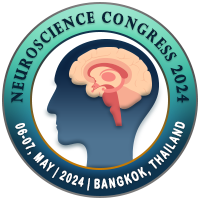.jpg)
Ke Wang
Shanghai Tenth People's Hospital; Tongji University, ChinaTitle: Management of post-neurosurgical patients with pyogenic ventriculitis caused by Multi/Extensive drug-resistant Acinetobacter baumannii
Abstract
Objective: To investigate clinical effect of intraventricular lavage and intraventricular
administration of polymyxins to manage the post-neurosurgical patients with
pyogenic ventriculitis caused by Multi/Extensive drug-resistant (MDR/XDR)
Acinetobacter Baumannii.
Methods: Thirty-nine patients with post-neurosurgical pyogenic ventriculitis due to
MDR/XDR Acinetobacter Baumannii at the Neurosurgical Department, Shanghai Tenth
People's Hospital were reviewed. All of them underwent intraventricular lavage
followed by daily intraventricular polymyxins injection. Intravenous antibiotic
strategy was mainly based on tigecycline / polymyxins combined with sulbactam.
Their clinical charts and 3-month follow-up status measured by the Glasgow
Outcome Scale (GOS) were analyzed. Results
Thirty-four patients (87.2%) were clinically cured and discharged, and 5
patients died. The mean duration of intraventricular administration of
polymyxins was 24.3 days. Hydrocephalus was present in 33 (83.3%) patients,
including 15 with multiloculated hydrocephalus, 18 with uniloculated
hydrocephalus, and 6 without hydrocephalus. The duration of intraventricular
injection of polymyxins was significantly higher in patients with
multiloculated hydrocephalus than in those without (31.0±16.6 days vs 20.1±13.1
days, P =0.028), and the GOS score was significantly lower than in patients
with multiloculated hydrocephalus than in those without [2(2,2) vs 3(2,4), P=0.017].
After the cure of infection, 30 patients (76.9%) underwent
ventriculo-peritoneal shunt, and 2 patients received lumbar-peritoneal shunt.
No recurrence of infection occurred in all patients after shunt.
Conclusion: Intraventricular lavage combined with intraventricular injection of polymyxins is an effective way for the treatment of post-neurosurgical pyogenic ventriculitis due to MDR/XDR Acinetobacter Baumannii. Hydrocephalus is a common complication and the occurrence of multiloculated hydrocephalus is associated with poor prognosis
Biography
Ke Wang completed his MD on the year of 2001 from Fudan University, China. Now, he works as an attending doctor at the neurosurgical department of Shanghai Tenth People’s Hospital affiliated to Tongji University, Shanghai, China. His clinical work is focused on the management of neurosurgical patients in critical conditions. His research was supported by the National Scientific Funding of China and the Shanghai Municipal Scientific Funding. He has over 20 publications as the first or corresponding author, and his work has been cited over 600 times.

